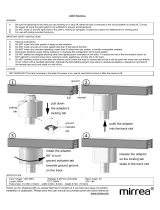
Stand-alone operation 17
controller. Doing so may cause damage to the electronics that is
not covered by the product warranty.
In master/slave stand-alone operation, one master luminaire transmits a
synchronizing signal to slave luminaires over the data link each time it starts
a new action. Slave luminaires start their next programmed action when
they receive this signal from the master luminaire. Programs can be
identical on all luminaires, or luminaires can – subject to certain practical
constraints – run programs that are synchronized but not identical.
Note that:
• Colors are always displayed in the order: red, then green, then blue. This
means that if red is activated, it will always be first in the program. If red is
not activated but green is activated, green will be first in the program.
• Each luminaire follows the program set on its own DIP switch as
described in "Table 1. Stand-alone DIP switch settings" on page 14.
More sophisticated light shows can be programmed using a DMX controller
(see “DMX controlled operation” on page 21).
The synchronization signal used by the Cyclo 03 Directional is identical to
that used in other 3-tube Cyclo luminaires, allowing these products to be
combined in master/slave operation on one data link. However, it is not
compatible with 4-tube Cyclos. Consult your Martin Architectural dealer if
you need advice on combining and controlling products.
Identical light shows
Master and slave luminaires can be set to behave identically. In this mode,
the master sends synchronizing signals to the slaves, and all luminaires run
the same light show. Each slave luminaire follows the program set on its
own DIP switch, so for identical operation, all luminaires’ DIP switch settings
must be the same apart from pin 9, which is set to ON for slaves and OFF
for the master.
Synchronized non-identical light shows
It is also possible to synchronize changes but program slave luminaires to
behave differently from the master. To use this feature effectively, you need
to plan your light show using scenes as building blocks and set the
luminaires’ DIP switches accordingly.
A scene is a change from one ouput to another. When a luminaire is in slave
mode, it starts a scene when it receives a synchronization signal from the
master. The time taken by the scene is determined by the speed setting of
the DIP switch. A slave will not respond to new synchronization signals until
its scene is complete.

























